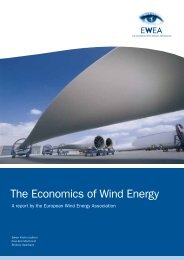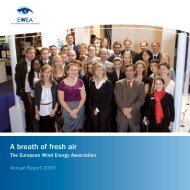Offshore Electricity Infrastructure in Europe - European Wind Energy ...
Offshore Electricity Infrastructure in Europe - European Wind Energy ...
Offshore Electricity Infrastructure in Europe - European Wind Energy ...
Create successful ePaper yourself
Turn your PDF publications into a flip-book with our unique Google optimized e-Paper software.
esults<br />
4.5 Overall grid design<br />
4.5.1 Approach<br />
The development of the offshore grid is go<strong>in</strong>g to be<br />
driven by the need to br<strong>in</strong>g offshore w<strong>in</strong>d energy onl<strong>in</strong>e<br />
and by the benefits from trad<strong>in</strong>g electricity between<br />
countries. This <strong>in</strong>volves on the one hand the connection<br />
of the w<strong>in</strong>d energy to where it is most needed, and<br />
on the other hand the l<strong>in</strong>k<strong>in</strong>g of high generation cost<br />
areas to low generation cost areas. There are numerous<br />
methodologies that could be applied to achiev<strong>in</strong>g<br />
these objectives. In this section, the <strong>Offshore</strong>Grid<br />
consortium demonstrates the effectiveness of two<br />
different methodologies to design a beneficial costeffective<br />
overall offshore grid.<br />
Both methodologies use as a start<strong>in</strong>g po<strong>in</strong>t the<br />
<strong>Offshore</strong>Grid Hub Base Case scenario 2030. This<br />
<strong>in</strong>cludes the direct or hub connections to each of<br />
offshore w<strong>in</strong>d farm <strong>in</strong> the North and Baltic Seas (as<br />
def<strong>in</strong>ed <strong>in</strong> section 4.2), and the offshore re<strong>in</strong>forcements<br />
identified <strong>in</strong> the ENTSO-E Ten Year Network<br />
Development Plan (TYNDP) [56]. Based on this, the<br />
follow<strong>in</strong>g design development strategies are applied:<br />
• The direct design Methodology mimics the current<br />
evolution as it is envisaged today: First, direct <strong>in</strong>terconnectors<br />
are built to promote unconstra<strong>in</strong>ed<br />
trade as average price difference levels are high.<br />
Once additional direct <strong>in</strong>terconnectors become<br />
non-beneficial, tee-<strong>in</strong>, hub-to-hub and meshed grid<br />
concepts are added to arrive at an overall grid<br />
design.<br />
• The Split design Methodology considers an approach<br />
that starts with a conclusion from the<br />
case-<strong>in</strong>dependent model (see section 4.4.4). The<br />
idea is that <strong>in</strong>terconnections are built by splitt<strong>in</strong>g<br />
the connection of some of the larger offshore w<strong>in</strong>d<br />
farms between countries. Thereby a path for constra<strong>in</strong>ed<br />
trade is established. These offshore w<strong>in</strong>d<br />
farm nodes are then further <strong>in</strong>terconnected to establish<br />
an overall ‘meshed’ design where beneficial.<br />
A large number of iterations and sensitivity analyses<br />
were carried out for each of the two methodologies 26<br />
<strong>in</strong> order to prove that each added <strong>in</strong>frastructure module<br />
was beneficial. Each of the methodologies is<br />
expla<strong>in</strong>ed <strong>in</strong> detail <strong>in</strong> the follow<strong>in</strong>g two chapters. The<br />
results are compared <strong>in</strong> section 4.5.4 to see which<br />
k<strong>in</strong>d of development is most efficient <strong>in</strong> terms of reduc<strong>in</strong>g<br />
<strong>Europe</strong>an total system generation costs.<br />
TAblE 4.6: ENERGY PRIcE dIFFERENcES (IN €/MWh) AS dETERMINEd bY POWER MARkET MOdEl FOR ThE hUb bASE cASE<br />
ScENARIO 2030<br />
BE De DK ee Fi Fr GB Ie lT lV Nl NO Pl se<br />
BE 4.6 9.7 6.4 23.7 10.1 9.4 8.2 6.9 6.4 7 17.5 6 25.9<br />
De 4.6 7.5 5.4 22.1 9.5 8.8 8.8 5.4 5.4 5.3 15.7 4.4 24.0<br />
DK 9.7 7.5 6.2 16.2 7.6 8.9 11.4 5.8 6.2 6.3 10.1 6.9 17.0<br />
ee 6.4 5.4 6.2 18.8 8.5 10.0 10.4 1.2 0.0 8.1 13.4 3.7 21.1<br />
Fi 23.7 22.1 16.2 18.8 16.5 20.3 23.4 19.0 18.8 20.7 9.9 20.9 7.3<br />
Fr 10.1 9.5 7.6 8.5 16.5 8.9 11.3 8.5 8.5 8.3 10.6 9.6 17.2<br />
GB 9.4 8.8 8.9 10.0 20.3 8.9 6.1 9.9 10.0 6.5 15.0 10.0 21.2<br />
Ie 8.2 8.8 11.4 10.4 23.4 11.3 6.1 10.6 10.4 8.6 10.1 10.2 24.8<br />
lT 6.9 5.4 5.8 1.2 19.0 8.5 9.9 10.6 1.2 7.8 13.4 2.8 20.5<br />
lV 6.4 5.4 6.2 0.0 18.8 8.5 10.0 10.4 1.2 8.1 13.4 3.7 21.1<br />
Nl 7.0 5.3 6.3 8.1 20.7 8.3 6.5 8.6 7.8 8.1 14.7 7.2 21.2<br />
NO 17.5 15.7 10.1 13.4 9.9 10.6 15.0 18.1 13.4 13.4 14.7 14.8 8.8<br />
Pl 6.0 4.4 6.9 3.7 20.9 9.6 10.0 10.2 2.8 3.7 7.2 14.8 22.1<br />
se 25.9 24.0 17.0 21.1 7.3 17.2 21.2 24.8 20.5 21.1 21.2 8.9 22.1<br />
26 Please note that the two methodologies only differ <strong>in</strong> the first step. The Direct methodology focuses first on direct <strong>in</strong>terconnectors,<br />
while the Split methodology focuses first on split w<strong>in</strong>d farm connections.<br />
58 <strong>Offshore</strong>Grid – F<strong>in</strong>al Report









